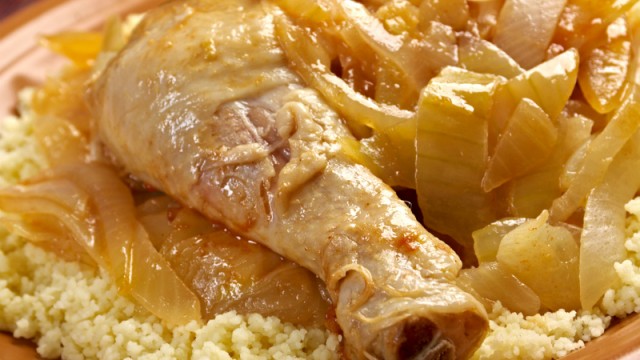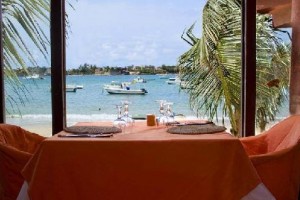With street food for sale on every corner, Atlantic waves brimming with fresh fish, and a rich local cuisine influenced by both Africa and Europe, Dakar is a foodie’s paradise. Here’s our guide to eating in Dakar, encompassing everything from peanuts to poisson.
Eat like a local
Dakar residents are proud of their culinary traditions, and take great excitement in introducing visitors to dishes like poulet yassa (chicken stewed in onions, spices, lemon and olives), thieboudjenne (fish or meat fried with eggplant, carrots and crispy rice) and mafe (chicken or beef cooked in a rich peanut butter). If you’re invited to someone’s home, don’t miss the opportunity: these dishes are served from big communal plates, and the hostess will often cut pieces of chicken to size for guests. In Senegalese culture, it’s hip to pile on a few pounds, so expect your host to be offended if you stick to small portions. Big, hearty meals are the cornerstone of Senegalese entertaining.
There are informal restaurant shacks all over Dakar that serve ultra-Senegalese plats du jour; basically whatever is fresh and takes the chef’s fancy. Among the more authentic is Adji’s thieboudjenne shack over by the plage de Ngor (on the left-hand side of the parking lot, opposite the USAID office.) For 1000 cfa per person, Adji serves up big plates of mafe or fish. Chez Aicha on the beach road in Les Almadies (next door to Le Paradis du Surfeur) offers up a similar deal, only with divine ocean views to match.
Street food
It would be rude to leave Dakar without trying dibi. The city’s favorite street food, it consists of greasy, spicy cuts of mutton roasted with onions and orange spice powder on a bed of brown greaseproof paper. If that doesn’t sound appetizing, just wait until you try it. There are centuries of Arab tradition wrapped up in those little parcels, and they taste best after a night out dancing or hearing live music. Every Dakarois has their favorite dibi spot, but you might try Mbote on La rue de Guele Tapee, or if you can find it, Youssou N’Dour’s local dibiterie, tucked deep inside the labyrinth of Marche Sandaga, and decked out with wrestling posters from the 1960s.
Besides dibi, don’t miss the Dakar-style fish and plantain fries served by a cheery woman by the roadside opposite Marche Soumbediounne; customers perch on old wooden benches, while the plantain fries bathe in thick sweet oil. Peanuts (les arachides), a hangover from French rule, are still a key component of Senegal’s export market. You can buy them from market women all over the city. Also look out for the sweet fried beignet donuts, and fresh coconuts, strawberries and mangos.
If you need a pick-me-up, purveyors of Cafe Touba — very strong coffee with enough sugar to induce a diabetic coma — push their trademark yellow and red carts all around the city. Attaya, a sugary tea, is also a street favorite; the ritual of pouring it sometimes seems to take up entire afternoons.
From the sea
The city by the sea certainly knows a thing or two about good seafood. One of our favorite seafood restaurants is the La Cabane du Pecheur (the Fisherman’s Cabin) on Plage de Ngor. Decked out with fishing paraphernalia, including giant Merlin and Barracuda caught off the Dakar coast, this is the perfect spot for a seafood Sunday brunch: try the surf n’ turf or the fresh grilled fish of the day. The friendly waiters will bring over the day’s menu on a chalkboard. Nearby at La Pointe des Almadies, relaxed informal spots serve the day’s catch. Fans are loyal to the baskets of clams, while the fresh thiof fish, served whole, is also excellent.
African flavors
As a regional African hub, Senegal sees a lot of visitors from other parts of the continent. There’s a good variety of West African eateries to explore from simple Ghanaian chop shops to Ivorian restaurant Le Zaouli (the poisson braise is delicious) on Rue Moussa Diop in Plateau. The Cape Verde archipelago is just a 90-minute flight away, and Dakar is home to a fun Cape Verdean diaspora. La Loutcha at 101 Rue Moussa Diop in Plateau gets rave reviews for its creative dishes, hipster decor and pretty back terrace.
For upscale pan-African dining, head to La Calebasse in Les Mamelles (on the main approach road, next to La Clinique des Mamelles.) The wooden structure is both an art gallery and a restaurant; browse the rooms devoted to hip woodcarvings before heading upstairs to dinner on the terrace. You can tuck into upmarket twists on West African favorites. In Point E, Ethiopian spot Lalibela (Rue de Louga) serves bayentu platters of spicy lentils and meat, sopped up with great injera bread. The rooftop terrace is a pretty special spot, with cushioned benches and tables made out of discarded oil drums. It’s so atmospheric that it’s often hired out for weddings.
Francafrique
Whatever you think about France’s colonial legacy, at least one good thing has come from it: the humble baguette. Dakar has a great selection of French-style boulangeries and patisseries, from street stands that sell just one variety, to fancy bakeries that name their olive and rye breads after local celebrities and politicians. Among the best is La Graine d’Or on the Route de Ngor in Les Almadies (about a mile before the roundabout for Le Virage). It also sells wonderful tartes au citron, chocolate cakes, croissants, creme brulee and macaroons. French import Eric Keyser in Plateau has a similar selection, plus great sandwiches and salads. For fine French dining, visit La Fourchette at 4 Rue Parent in Plateau; the chocolatey desserts are unbeatable.


